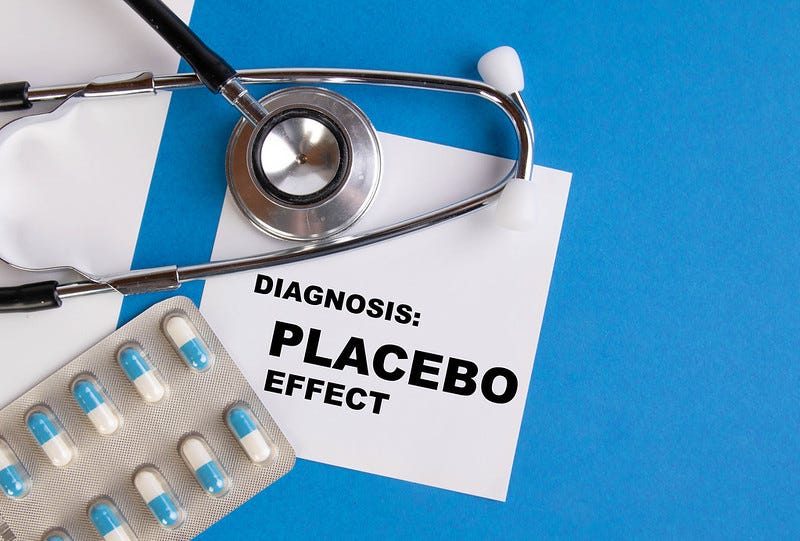The placebo effect in the treatment of gender dysphoria
An understudied phenomenon
Photo by Marco Verch
Study under review:
Clayton, A. Gender-Affirming Treatment of Gender Dysphoria in Youth: A Perfect Storm Environment for the Placebo Effect—The Implications for Research and Clinical Practice. Arch Sex Behav 52, 483–494 (2023). https://doi.org/10.1007/s10508-022-02472-8
Australian psychiatrist Alison Clayton investigates the ways in which a placebo effect may be at play with gender affirming medical treatments — independent of the impact of interventions such as hormones and/or surgeries on gender dysphoria. If a placebo effect is at work, this would have serious implications for clinicians and clients alike.
What if the improvements clients are experiencing following the start of hormones, for example, are due to getting care and attention, and not due to the hormones themselves? Then again, does understanding the mechanism of improvement matter — as long as the client is getting better? Clayton answers these questions by looking at what the research says.
A placebo effect is the beneficial effect that may happen in certain treatment contexts independent of a specific intervention. Basically, anything that increases a client’s expectation of a positive outcome may contribute to a placebo effect. Researchers even have a name for when client improvements occur in a clinical trial, not because of the treatment, but simply because the client is being observed and receiving extra attention — it’s called the ‘Hawthorne effect’.
Placebo effects are real and can even be long lasting… so what’s the problem? Why should we care if the effects are due to placebo rather than due to a particular intervention?
Knowing whether a placebo effect is at play is critical because the treatments in question can come with significant long-term adverse health complications, including cognitive, bone density, cardiovascular, and fertility impacts.
The risks of Gender Affirmative Treatment
What is called Gender Affirmative Treatment (GAT) often involves affirming a person’s social identity, providing puberty blockers (in the case of youth), cross-sex hormones (in the case of adolescents and adults), and performing highly invasive surgeries, including genital surgeries with high complication rates, to align a person’s physical body with their felt gender.
Proponents of GAT argue that the treatments help improve quality of life and mental health outcomes. However, a close look at existing studies in the US and Europe does not confirm this, as Clayton correctly points out.
Clayton draws a parallel between GAT and medical lobotomies, which were hailed as a miracle cure based on little more than expert opinion and a dearth of actual scientific evidence. Lobotomies are considered barbaric today but were once seen as a progressive form of medicine. The risks of harm from an over-reliance on expert opinion without a solid evidence base are real.
A perfect storm
Clayton notes that we have a rising number of young people presenting with a condition, gender dysphoria, for which we have no objective test. Healthcare providers are responding with a one-size-fits-all medical treatment plan that does not seem to take into account the various reasons why a young person (or adult) might seek to change their gender (e.g. traumatic experiences, wanting to avoid puberty, body dysmorphia, relational difficulties, internalized homophobia). The scientific evidence-base that currently exists, is built mainly on a very different demographic (previously natal males seeking services greatly outnumbered natal females; the reverse is true today).
Clayton argues that these invasive medical procedures are recklessly promoted as ‘life-saving’ while their adverse side effects are downplayed. In contrast, psychosocial interventions such as psychotherapy — which come with much less adverse health risks — are tarred as ‘harmful’ and ‘conversion practices’, especially if they seek to help a client accept their body as is.
Some GAT proponents have used the risk of suicide as a reason to justify medical interventions sooner rather than later for youth; however here, too, the evidence is sparse. While suicide risk is elevated among gender dysphoric youth compared to the general public, Clayton points out that it is relatively similar to the risk among youth accessing child and adolescent mental health services for reasons other than gender dysphoria. Promoting an overly simplistic narrative to the public around suicide risk and gender dysphoria may well generate a nocebo effect (a ‘self-fulfilling narrative’).
What’s the alternative?
Clayton suggests that how the media talks about gender dysphoria and how clinicians talk with families matters. She suggests that in addition to celebratory stories about medical transition, we need to platform stories of individuals who were able to learn to manage their gender dysphoria without medical interventions; including stories of clients who have, through psychotherapy, learned skills to manage their symptoms. We also need to listen to the stories of those who have had negative transition experiences, including health complications or experiences of regret. We need to listen to detransitioners. Only once all these different stories are all platformed can youth and their families make a truly informed decision on the options available to them.


